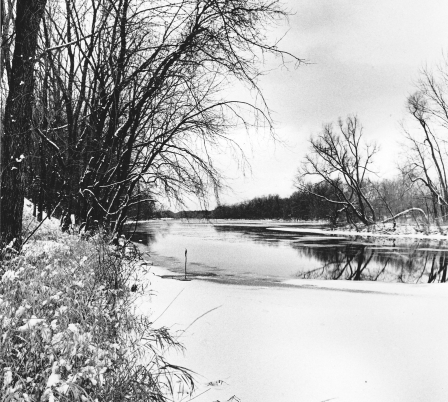
|
|
From about 1865 to 1936, Bass River was an active community. It was located in the northwest corner of Allendale Township, west of Eastmanville, where the Bass River joins the Grand. On July 18, 1882 Andrew J. White was named the first Postmaster of this small settlement at a landing on the Grand River [Section 7 of Allendale Township], a position he still held in the early 1890s. The office closed on September 30, 1910. Around 1900 Bass River was larger than Allendale. It had two stores, a post office, church, school, and sawmill, and there was a landing for vessels like the Mae Graham, where passengers could be picked up or dropped off, and strawberries, beans, and grapes could be sent down river for shipment across Lake Michigan. Before white settlers arrived, it was a trapping and fishing site for Fox, Muskotay, and Potawatomie Indians, and long before their time, the glaciers left some of the richest and most extensive stores of gravel in the area. As that natural resource was mined, farms were purchased, people moved out, and gravel companies moved in. Gradually, the town disappeared, most of the original sites were under water, and the gravel was gone.[Adapted from an article by Karin Orr, Grand Rapids Press, January 1, 1989.]
BASS LANDING, Ottawa County: this settlement at a landing on the Grand River, in Allendale Township, was given a post office named North Robinson, on March 23, 1877, with Joseph G. Failing as its first postmaster, the office operating until August 28, 1879 [GSM 1881; PO Archives]Located at a landing on the Grand River near the west line of Allendale Township, Bass Landing also had the name North Robinson. Joseph G. Failing became the first Postmaster of North Robinson on March 23, 1877. The federal office closed on August 28, 1879.
BASS RIVER, Ottawa County; this settlement at a landing on the Grand River was given a post office on July 18, 1882, with Andrew J. White as its first postmaster, the office operating until September 30, 1910 [GSM 1883; PO Archives]
The Postmaster at Bass River in 1892 was A.J. White.
Michigan Place Names: The History of the Founding and the Naming of More Than Five Thousand Past and Present Michigan Communities, Walter Romig, 1986
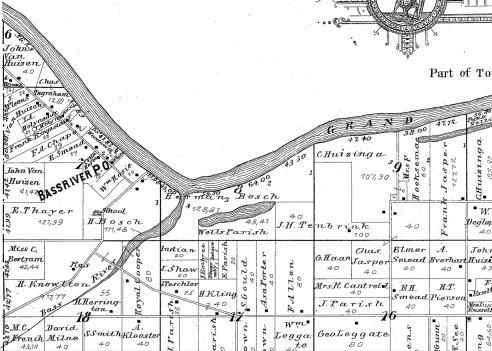 |
| Bass River area plat in 1897 |
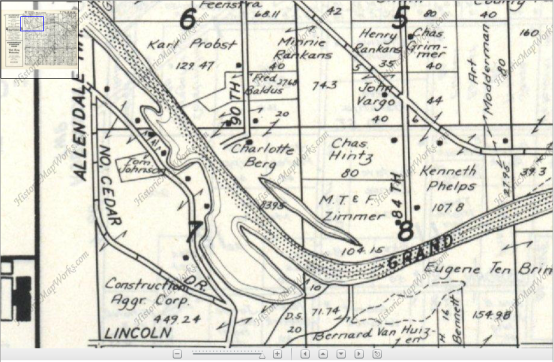 |
| Bass River area plat in 1955 |
The boarding house was across from the school and a little south but on the same road.The hotel (they called it a resort) was west 3 or 4 buildings from the store in a big old Gothic house. The driveway was lined with huge trees and had a front porch that went all the way across the front that looked out over the river and the steamboat dock.
"Robinson Farm Resort," on Grand River, ten miles from Grand Haven. Omnibus from latter point or boat up Grand River. Literature mailed on request from George Burmeister, manager Robinson Farm Resort, Grand Haven, R.F.D. No. 1, accomodates thirty, $1.00 to $1.50 per day; $6.00 to $8.00 per week.[In the early 1900s Albert Kaminski and his wife, Ottile, owned and operated Robinson Farm Resort on 80 acres in Section 2 of Robinson Township. The northeast corner of the property provided access to the Grand River. The two-story, frame home with a wrap-around porch burned to the ground in May, 1920. Alfred Robinson, an early settler, built the home around 1870.]
Frank A. Chapel, R.F.D. No. 3, seven miles from Coopersville, nearest station; accomodates twenty; $1.50 per day; $7.00 per week. Known as Evergreen Farm Resort; on Grand River; boats leave Grand Haven daily via the river. Literature on request.
Mrs. H. Weber, nine miles from Grand Haven; reached by livery or steamer; accomodates thirty; rates $1.50 per day, $8.00 per week.
Michigan Summer Resorts, Pere Marquette Railroad, 1913
BASS LANDING, referred to as NORTH ROBINSON
A recently established postoffice at Bars Landing, on the Grand river, in Allendale township, Ottawa County, 12 miles southeast of Grand Haven, the county seat, and 5 northeast of Robinson, on the Chicago and West Michigan Railroad, from whence it receives a weekly mail by stage. Fruit only is exported. Population, 75. E. G. Norcross, postmaster.Harper W C, express agent at Robinson
Norcross E G, Fruit Grower
Michigan state gazetteer, 1879
A postoffice in Ottawa County, located on the Grand River, 14 miles southeast of Grand Haven, the county seat. It is a landing on Grand River, and its nearest railroad and banking point is Grand Haven. Population, 50. Mail, semi-weekly. William Rowe, postmaster.Brown Charles O, saw mill
McDonald William H, dentist
Molyneux Jesse, justice of peace
Rowe William, General Store
Sherman Benjamin, blacksmith
White A J, grocer
Michigan state gazetteer, 1887
A postoffice in Allendale township, Ottawa County, and a landing on the Grand river, 12 miles southeast of Grand Haven, the county seat and railroad point. Nearest bank at Coopersville, 7 miles distant. Population, 65. Mail, daily. A. J. White, postmaster.Deeno C, agent
Herrington H, constable
Pansler Charles, carpenter
Sherman B F, blacksmith
White A J, General Store and Justice
Michigan state gazetteer, 1891-1892
A postoffice in Allendale township, Ottawa County, and a landing on the Grand river, 14 miles southeast of Grand Haven, the county seat and railroad point. Population, 80. Stage daily to Grand Rapids: fare, 75 cents. Mail, daily. A. J. White, postmaster.Bosch H, saw mill
McCue H, grocer
Dennis Charles, optician
Herrington H, constable
Pansler Charles, carpenter
Sherman B F, blacksmith
Tripp J S, musician
White A J, General Store and Justice
Michigan state gazetteer, 1893-1894
Population, 75. A postoffice in Allendale township, Ottawa County, and a landing on the Grand river, 14 miles southeast of Grand Haven, the county seat and railroad point. Stage daily to Grand Rapids: fare, 75 cents. Mail, daily. J. H. McCue, postmaster.Bosch H, saw mill
Pansler Charles, saw mill
Porter, Smead & Franch, feed mill
Sherman B F, blacksmith
Tripp J S, musician
White A J, General Store and Justice of the Peace
Michigan state gazetteer, 1897
Population, 100. In Allendale township, Ottawa County, on the Grand river, 14 miles southeast of Grand Haven, the county seat and railroad point, and 20 from Grand Rapids. Has a Congregational church. Stage daily to Grand Rapids: fare, 75 cents. Telephone connection. Mail, daily. A. J. White, postmaster.Bosch H, saw mill
Citizens' Telephone Company, Toll Station, A J White Agent. Porter & Smead, feed mill
Sherman B F, blacksmith
Southfield Brothers, saw mill
White A J, General Store and Notary Public
Michigan state gazetteer, 1903-1904
Population, 60. In Allendale township, Ottawa County, on the Grand river, 14 miles southeast of Grand Haven, the county seat, banking and railroad point, and 21 miles from Grand Rapids. Has a Congregational church. Stage daily to Grand Rapids: fare, 50 cents. Telephone connection. Mail, daily. A. J. White, postmaster.Graham Robert J., meats
White A J, General Store and Notary
Michigan state gazetteer, 1907-1908
Residents in Allendale Township
| Name | Section | Occupation |
|---|---|---|
| Amigh, George W | 7 | Farmer |
| Bryant, Amos | 7 | Farmer |
| Bertram, Charlott | 18 | Farmer |
| Bosch, Harm | 8 | Mill Owner and Farmer |
| Bushma, Simon | 19 | Farmer |
| Cooper, Royal | 18 | Farmer |
| David, James | 17 | Farmer |
| Embra, Isaac | 17 | Farmer |
| French, Matthew C | 18 | Farmer |
| French, Lincoln | 18 | Farmer |
| Hodges, Charles | 7 | Farmer |
| Hoogland, John | 7 | Farmer |
| Harrington, Harmon | 18 | Farmer |
| Ingraham, Charles W | 6 | Farmer |
| Kling, Henry | 17 | Farmer |
| Kloster, Albert | 18 | Farmer |
| Knowlton, Hiram | 18 | Farmer |
| Leggatt, William | 17 | Farmer |
| McMillan, Peter | 19 | Farmer |
| Molyneux, Loyd A | 7 | Farmer |
| Molyneux, Jesse | 7 | Farmer |
| McCue, Henry | 7 | General Merchant |
| Peters, Henry | 19 | Farmer |
| Parish, Fred | 17 | Farmer |
| Parish, Enos | 17 | Farmer |
| Parish, John | 17 | Farmer |
| Porter, Asa | 17 | Farmer |
| Rypma, Garrett | 19 | Farmer |
| Ringnolds, Frank | 7 | Farmer |
| Rosie, William | 7 | Ferry Proprietor and Farmer |
| Rice, George | 18 | Farmer |
| Scott, Avery J | 22 | Farmer |
| Scott, Walter | 27 | Farmer |
| Smith, Daniel | 22 | Farmer |
| Sweet, Lewis | 30 | Farmer |
| Shogonobey, Jacob | 17 | Farmer |
| Shaw, Jacob | 17 | Farmer |
| Sheffield, Egbert | 20 | Farmer |
| Sheffield, H H | 20 | Farmer |
| Shippers, William | 20 | Farmer |
| Shippers, Leonard | 20 | Farmer |
| Stratsma, George | 19 | Farmer |
| Stratsma, Peter | 19 | Farmer |
| Sherman, Benjamin | 7 | Blacksmith |
| Smead, Elijah | 7 | Farmer |
| Savinskie, Martin | 35 | Farmer |
| Vanhuizen, John | 7 | Farmer |
| White, Andrew | 7 | Postmaster and General Merchandise |
| Warbus, Charles | 18 | Farmer |
| Wierda, Jacob | 19 | Farmer |
Historical and Business Compendium of Ottawa County, 1892-3
Residents in Robinson Township
| Name | Section | Occupation |
|---|---|---|
| Butrick, Erastus | 11 | Farmer |
| Butrick, Adelbert | 11 | Farmer |
| Bartholomew, Harry | 12 | Farmer |
| Balcom, Moses | 12 | Farmer |
| Daniels, Mrs.Reuben | 12 | Farmer |
| Denio, Charles D. | 1 | Farmer |
| Foster, Edmond | 24 | Farmer |
| Foster, A.D. | 13 | Farmer |
| French, Matthew C. | Seciton 13 | Farmer |
| French, Byron C. | 13 | Farmer |
| Griswold, William | 11 | Farmer |
| Guisler, Fred | 1 | Farmer |
| Graham, Thomas | 13 | Farmer |
| Graham, Fred | 14 | Farmer |
| Hannan, Isaac | 2 | Farmer |
| McCue, N.E. | 12 | Farmer |
| Newton, George W. | 12 | Farmer |
| Nichols, John E. | 13 | Farmer |
| Nichols, W.B. | 24 | Farmer |
| Nichols, James | 13 | Farmer |
| Prentice, John | 3 | Farmer |
| Robinson, Charles | 3 | Farmer |
| Robinson, Alfred | 2 | Farmer |
| Robinson, Ransom H. | 35 | Farmer |
| Robinson, Ira | 1 | Farmer |
| Ralya, William | 24 | Farmer |
| Ralya, Charles W. | 13 | Farmer |
| Thompson, Gilbert | 1 | Farmer |
Historical and Business Compendium of Ottawa County, 1892-3
|
|
As shown by the story of Port Sheldon, in the first half of the nineteenth century Eastern investors saw an opportunity to make money by platting cities and towns in Michigan to attract the large numbers of people moving west, thanks to the opening of the Erie Canal in 1825. Unfortunately, many of these plats became "paper cities," including Warren City, which was platted in 1836 to have 90 river lots and 500 back lots. Located on the south side of the Grand River and west of the mouth of the Bass River, on the Robinson and Allendale Township lines, it failed to attract any permanent residents. In 1840 Warren City was selected by the Board of Supervisors to be the County's seat, but official business continued to be carried out in Grand Haven. Plat maps of the nineteenth century show some of these "paper cities." David Smith was one of the few residents of Warren City along with some Native Americans. George W. Amigh in Section 7, Jesse Molyneux in Section 7, and Charles W. Ingraham in Section 6 were early fruit farmers.
Warren City was another pioneer adventure, and found its location just west of Bass River, facing Grand River. A plat was made in 1837, which was entered in the plat book at the recorder's office; but it was never recorded; the streets were never named nor the blocks numbered; the names of the proprietors are not given on the plat, and the title was conveyed by the State some years after; so it is safe to conclude that the town was pre-eminently a paper town. David Smith, who married a half-breed woman, lived for several years in Warren City; himself and wife and a large number of Indians constituting the population. In those days Grand River was lined with Indians, but at the present time Allendale is the only township in the county in which Indians are to be found. Quite a number camp near the mouth of Bass River. About 1840 the county commissioners located the county seat at Warren City, and never removed it. The town was never a success in the county seat business, but makes excellent fruit farms.Historical and Business Compendium of Ottawa County, Michigan, 1892
In 1831, Ottawa County was designated as a territorial County and in 1836 it was attached to Kent County for judicial purposes. Ottawa County was organized by an act of the Michigan legislature on December 29, 1837. At the time, the County included part of what is now Muskegon County. The County Board of 1838 ordered that court was to be held in Grand Haven until further notice. In 1839, the Michigan legislature enabled the appointment by the governor of three county commissioners. The commissioners were directed to impartially select a location for the County seat, considering the County's present and future population. In 1840, the County Commission selected Warren City in Robinson Township (a city on paper only) as the County seat. At that time there were only 208 people and five townships in the County, (Ottawa, Georgetown, Tallmadge, Norton and Muskegon). In 1846, the County population had swelled to 1,200. The County seat was never moved from Grand Haven even though there were votes by the Board of Commissioners in 1856, 1857, 1858 and 1864 to move it to places other than Grand Haven. By 1850, the County population had grown to almost 8,500.
|
|
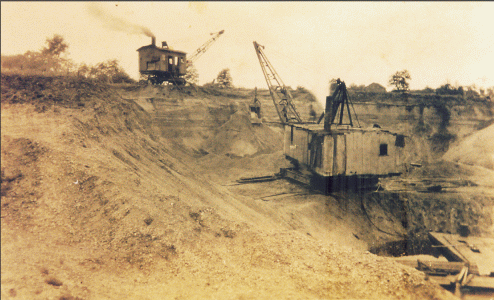 |
| Gravel mining cranes circa 1925 |
The series of glaciers that crept down from the north many millennia ago bulldozed the rock and ground it into large deposits of gravel and sand, referred to as aggregate. As the need for paved roads grew with the expansion of the automobile industry, so did the demand for aggregate, one of the essential ingredients for concrete. One company organized locally for that purpose was Construction Aggregates, initially called Construction Materials Corporation. Three men from Chicago guided the destiny of this company since it was founded in 1907: Mandel Sensibar, founder; his son, Jacob R. Sensibar, President from 1911 to 1964; and another son, Ezra Sensibar who succeeded Jacob and became President and Chairman. In 1922 the company purchased [from Ralph Van Tol and John Walsma] a large amount of property eleven miles up the Grand River at Bass Creek, which constituted a vast area of gravel beds. In 1923 the owners of Construction Aggregates located their plant on sand-filled marshland along the Grand River in Ferrysburg. The company screened and graded gravel for more than 100 specifications and sold it to the road building and contracting industry.Gravel was brought on barges down river from the Bass River quarry to the Ferrysburg screening plant, where graded materials were loaded on cargo ships such as Baystate and Andaste and shipped to Chicago.
The name of the firm was changed to Construction Aggregates in 1948.
The firm closed the gravel pit acreage at Bass River in 1974. The State of Michigan was interested in the 1,100 acres at Bass River for a public park.
In 1907, the Construction Materials Corporation was established for obtaining and processing sand and gravel. Wooden scows, loaded by hand with wheelbarrows, were pushed by tug 16 miles downstream from the Bass river gravel pits. Wooden tugs were powered by steam engines built by Johnston Bros.
Bass River Landing was located on a high gravel bluff on the Grand River west of the mouth of the Bass River. Later known as the Village of Bass River, this farming community included a saw mill, general store and a number of houses. Bass River citizens operated summer resorts which were popular with residents of Grand Rapids, Chicago and as far away as St. Louis. However as time went on, the site became most known for the excellent gravel it contained. Mining interests supplanted the community; which was bought out and literally undermined.Gravel mining began in the 1880's and slowly the land around the village was eaten away by steam shovels. A mining company called Construction Aggregates began operations in 1920 and operated large scale gravel mining until 1976 with river barges hauling gravel to Grand Haven, where it was processed and loaded onto freighters for many destinations.
Gravel from this site has been used for many prominent building footings in Chicago and other cities in the Midwest, not to mention providing the material for almost all of Ottawa County's early roads.
In the 1960's, mining also yielded two startling artifacts - a large fossil bone that was determined to be part of a prehistoric .Mammoth'; and also the tooth of a Mammoth. The bone is currently at the Michigan State University Museum; the tooth resides with the Grand Rapids Museum.
The property was acquired by the State of Michigan in 1994 and today is a 1,665 acre undeveloped state park known as the Bass River Recreation Area.
Sources: Donald W. Linebaugh, Dr. Carl Bajema , James Ponshair, Marjorie Viveen, Wallace K Ewing; Olive Wilhems Gleans, Ruth Bethke Horton
F.W. Snyder Dies at Age 76
GRAND HAVEN - Forrest W. Snyder, 76, of 8952 Buchanan St., West Olive, died late Monday in a local nursing home following a long illness. Born in Georgetown Township, he had lived in the West Olive area most of his life. He retired in 1961 after 30 years of employment et Construction Aggregates Ferrysburg and Bass River plants. He was a veteran of World War I and a member of Robinson Baptist Church. Surviving are three sons, Forrest of Grand Haven, Claude of Grand Rapids and Lee of Milan; three sisters, Mrs. Floyd Lowing of Allendale, Mrs. L. D. Taylor of Spring Lake and Mrs. Clifford Chase of Grant; five brothers, Milo of Phoenix, Ariz.. Fred, Frank and Charles of Allendale and Howard of Spring Lake: 12 grandchildren and 13 i great-grandchildren.
Holland City News, February 26, 1970
CLOSING
From a letter to the Corps of Engineers from Construction Aggregates dated August 2, 1976:
The quality and quantity of sand and concrete aggregates that is available from our Bass River pit has diminished to a point where further extraction is no longer economically feasible.
|
|
The Hennepin was built in Milwaukee in 1888 as a wood-hulled steamer named George H. Dyer. It was 208 feet long, 35 feet wide and had a draft of 22 feet. It sported a large cargo container rated for 1,600 tons - perfect for hauling bulk cargo like gravel. In 1898 the ship was sold and the new owners renamed her Hennepin.After catching fire in 1901, she was sold to Lakeshore Stone Company and fitted with a conveyor system designed to speed up the loading and unloading of gravel and crushed stone. This made her the world's first self-loading vessel and a model for future ships to follow.
In 1922 or 1923 [sources vary] she was bought by Construction Materials Corporation, a Chicago company founded in 1907. While the ship was old and tired, its unloading equipment made it valuable to a company which had just purchased 1,100 acres of property several miles up the Grand River from Grand Haven, Michigan. The property contained vast deposits of stone ready to be mined and the Hennepin would be used to haul the aggregate. (Today the quarry has filled with water and is the site of the Bass River Recreational Area in Ottawa County.)
After being quarried, stone was brought down the Grand River to Ferrysburg, Michigan where it was sorted into different sized gravel and rock, then loaded onto ships and transported to Chicago. Much of the gravel hauled to Chicago on the Hennepin was used as fill, becoming the bed for the Outer Drive, Field Museum, Shedd Aquarium, and Adler Planetarium.
On August 18, 1927, Hennepin sprang a leak while being towed back to Grand Haven from Chicago. The crew were unable to save the ship and she sank off South Haven at about 6 pm with no loss of life. A year later Construction Materials Corporation replaced the Hennepin with the Andaste, a 266-foot ship built in Cleveland in 1892.
Just two years after the Hennepin sank, the Andaste - owned by the same company, running the same route, delivering the same cargo, and equipped with a similar prototypical unloading system - was swallowed up just miles from her predecessor. The ship took with her Captain Albert Anderson, who piloted the tug Lotus when the Hennepin sank, and all 28 crew members, many of who crewed on the Hennepin.
On the afternoon of Monday, September 9, 1929 the Andaste was docked at Ferrysburg, Michigan, up the river from Grand Haven, taking on a load of gravel. She passed the Grand Haven harbor pier heads at 9:03 PM, heading west-southwest across the southern end of Lake Michigan toward Chicago.
At about ten PM, a stiff wind arose, later becoming a full gale. Andaste was late for her scheduled arrival at South Chicago on Tuesday, but since she was often late and lacked radio equipment, no one raised an alarm until Wednesday. The bodies of 14 of the 25 crew members ultimately floated to shore, 11 of them wearing life jackets.
An inquest into the sinking recommended that (a) all ships should be equipped with wireless (radio) equipment, (b) that a central office maintain shipping schedules and promptly report delays, and (c) that adequate search and rescue capabilities be maintained on all of the Great Lakes.
|
|
Although there were some roads in the early days of Northwest Ottawa County, the rivers provided the most important routes for transportation and communication and proved an indispensable necessity in the development of the county. The names of landings along the Grand River, beginning with Grand Rapids and traveling west, were Freeman Godfrey's Plaster Mills, Hovey's Plaster Mill, Grandville, Chilsion's, Harreses, John Hare's, Sand Creek, Blendon Bluffs, Stoddard's Bend, Steele's Landing [Lamont], Richard Robert's Sawmill, Charleston, Eastmanville, County Poor House, Bass River, Ottawa Center, Spring Lake, Sisson, and Lilley Sawmill, Ferrysburg, and Grand Haven. Boats appeared to stop at least every mile, and many times in between, for all a person had to do to stop the boat was to go out and wave.Directory of Historical Topics in Northwest Ottawa County, Wallace K. Ewing, Ph.D.
In 1857 the Blendon Lumber Company purchased a seven-year-old Michigan Central locomotive and began hauling logs on wooden rails. They built their railroad southwest from the Grand River several miles into the Bass River valley to reach "2500 acres of good pine, almost in a body, on a part of which there was some good white oak." Old Joe, as the Blendon locomotive was affectionately known, hauled 100,000 board feet in 3-4 daily trips. The logs were dumped into the Grand River at Blendon Landing (now the southeast corner of Grand Valley State University's campus) and floated down to the Nortonville sawmill (just upstream from the site of present-day Spring Lake).Geography of Michigan and the Great Lakes Region, GEO 333 at Michigan State University
|
|
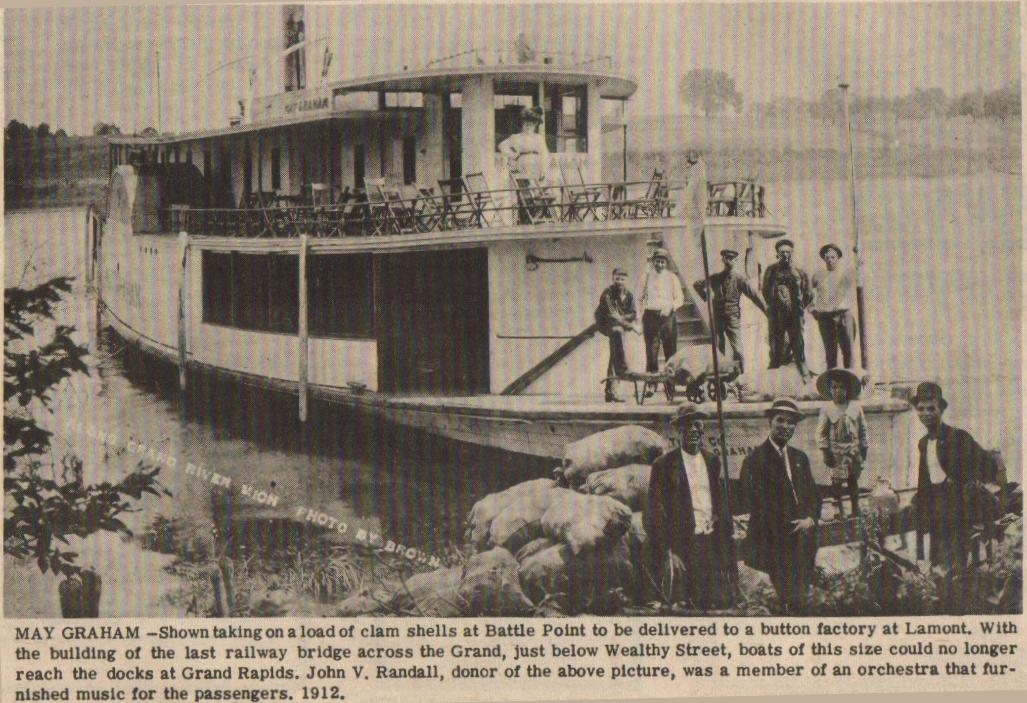 |
The May Graham, shown above in a 1912 photograph, is said to have been the last Grand River steamer, and at that time was apparently as much an entertainment vehicle as a freight operation.The May Graham weighed 91 tons and had a loaded draft of just 30 inches. The river was not all that deep compared to, say, the Mississippi River, and mostly operated west of the city, connecting Grand Rapids and smaller towns along the river with Grand Haven and Lake Michigan.
A steam-powered, two-sided wooden paddlewheeler named the May Graham, hull number U.S. 91173, was built for Edmon A. Graham in 1879 at the Preston & Shaw lumber yard in St. Joseph, Michigan. She was named after Edmon's only child, May Belle, and was launched on March 29, 1879.
Weighing 91 tons but with a draft of just 30 inches, she began service hauling lumber between Berrien Springs and the Graham family saw mill in Benton Harbor. Soon she began carrying paying passengers and freight, mostly fruit from local growers, between Berrien Springs and St. Joseph.
The May Graham was withdrawn from service in 1908 and sat idly on the St. Joseph river for three years until she was purchased by the Crosby Transportation Company, refurbished, and moved north to work the Grand River.
Her first trip on the Grand River took place on June 19, 1911, when she began making daily trips between Grand Haven and Lamont, a distance of about 22 miles. She carried passengers, about 5,000 each year, and hundreds of tons of freight, much of it fresh fruit destined for Chicago and Milwaukee via overnight trans-lake boats. (The overnight trips across the lake were much gentler on the fruit than the bumpy, dusty land routes at the time, and the cool lake water made refrigeration unnecessary.)
Increasing rail and automobile traffic eventually proved more cost-effective than riverboat transport, and the May Graham was retired from service at the end of the 1917 season. She was officially listed as "Abandoned" in 1921.
The pilothouse was removed and placed on the west side of the Grand River, at the future site of North Shore Marina. When the marina was built in 1952, the pilot house was relocated; this time to the north side of the Grand River, east of Grand Haven.
We are now approaching the strawberry season. Already big loads of the fruit raised in Bass River and Allendale are brought down each day and shipped to Chicago and the berry picker is in his element. Some people become very proficient in picking berries and fill over 100 quarts in a day when the berries are good and ripe.
The Evening Tribune, Grand Haven, Michigan, June 13, 1894
James John, a Bass River Indian, was sent to jail for five days by Justice Pagelson this morning for drunkenness.
The Evening Tribune, Grand Haven, Michigan, June 18, 1894
|
|
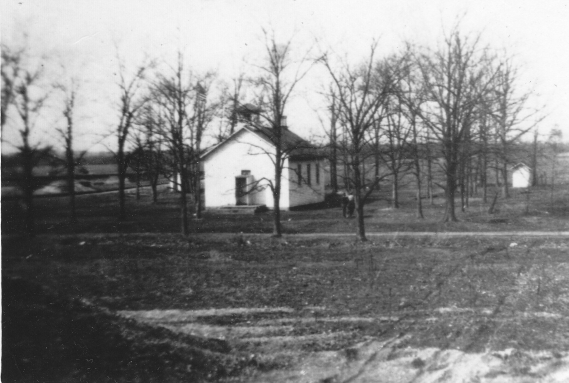 |
| Bass River School circa 1936 |
Ottawa County Commissioner Gives Statistics on Opening of Rural Schools (dated August 28, 1936)Allendale Township
Allendale High School Stanley Boven, Principal White School Mrs. Doris Plant Star School Lois VanSomeren Curry School Enno Keegstra Tuttle School No report Parish School Mary E. Wolbrink Bass School Closed Brotherton School Mrs. Mildred Scott Blakeney School Elsa M. Vannatter VanWestenburg School Closed Some of the rural schools of Ottawa county will begin their 1936 sessions as early as August 31 this year. It is expected the schools will take a week's vacation in October for potato harvesting, according to G. G. Groenewoud, Ottawa county school commissioner. The remaining schools will begin the Tuesday after Labor Day.
By the term "Rural School" is meant those schools which are not located within the incorporated limit of any city or village. Ottawa county has 123 school districts, each of which has one school, with the exception of School District No. 1 Park township, which has three schools and employs nine teachers. The enrollment in this particular district is 275, which of course, makes it the largest rural school district in the county.
Not all of the 123 school districts hire teachers, however, for if any one district has an enrollment so small that it would not be worthwhile to hire a teacher, arrangements are made so that the district provides transportation and tuition and the children are sent to a nearby school. Schools in these districts are called "closed schools". The people located in a school district can determine, by vote, whether or not a teacher should be hired or the school closed. At the present time there are five closed schools in the county. The Reister school transports its children to the Porter school, and the Lachman school transports its children to the Lisbon school. Those schools are in Chester township. The Van Westenberg school in Allendale township, transports its children to the Allendale high school, and the Spoonville school in Crockery in Crockery transports its pupils to the Nunica high school. The Bass River school district is taking steps to close its school and send the children to the Parish school, in Allendale township for the coming year. In the 123 school districts, five of which employ no teacher, there is a total of 161 teachers employed. There are 86 schools employing one teacher; 22, two teachers; 4, three teachers; 3, four teachers; one district employing six teachers and one district employing nine teachers in its three schools.
Each school district is an independent unit, being entirely under the control of its own school. The board hires the teachers, janitor, and other employees; makes all reports; adopts text books; takes the school census and does all that is necessary for the maintenance and success of the school.
During the school year of 1936-1937 many of the school districts will furnish text books and supplies for all the pupils, so that it will no longer be necessary for the parents to bear this additional expense.
Five hundred thirty-four pupils graduated from the eighth grade rural schools last spring; a majority of whom are expected to enter high school this fall. Mr. Groenewoude states that it is not necessary to make application to enter one of the high schools and that the State pays the tuition. It is, however, necessary for the student to buy his, or her, own books and supplies. Six of the rural schools taught some high school subjects last year, but few reached above the tenth. Coopersville, Marne and Hudsonville are the only twelve-grade schools in this area.
[ The 1892 edition of Historical and Business Compendium of Ottawa County lists a Gerret Groenewoud in section 23 of Olive Township, post office of Olive Center, occupation farmer.
Gerret G. Groenewoud of Holland is listed in the 1932 edition of Patterson's American Educational Directory and in 1935 Educational Directory published by the U.S. Department of the Interior. ]
He Stuck by ItHOLLAND Gerrit G. Groenewoud decided 30 or more years ago that his fourth-grade education didn't go far enough, so he enrolled at Ferris Institute, Grand Rapids, with the idea of preparing for better work than that on the farm. He didn't realize that education was to be his life work. He resigned recently as school commissioner of Ottawa County and turned over to his successor, Dick H. VandeBunte, one of the most outstanding rural school systems in the state. Groenewoud, who now has the title of professor, enrolled at Ferris when he was 24, spent four years there and passed a teachers' examination. He taught a year in Chippewa County then attended Ypsilanti Normal College. Before he became Ottawa commissioner he taught a year in Dickinson County, served as principal of Allendale schools near Grand Rapids for a year, at tended Michigan State College and followed through by teaching for eight years.
From the Detroit Free Press, July 30, 1939
|
|
This little settlement disappeared long ago. It was located in Crockery Township south of Nunica on the Grand River by Crockery Creek. Indian mounds were near this site which was named for John Spoon who built a sawmill there in 1856. Grand Valley State University has had archaeological digs at Spoonville.
|
|
Another "lost town" in Ottawa County, a few miles north of Bass River. Click here for more.
|
|
Bass River Recreational Area was acquired from Waste Management Inc. in 1994 for outdoor recreation purposes and was assigned to Parks and Recreation Division (PRD) to administer as a State Recreation Area.
Bass River Recreation Area is located within Ottawa County, a 565 square mile county located along the eastern shoreline of Lake Michigan. The largest river in Michigan, the Grand River, traverses the entire county before it enters Lake Michigan. The county is in the center of three vibrant metropolitan areas: Grand Rapids, Muskegon and Holland, the connection between them having strong influence on the county - a result of their geographic, economic and cultural relationship.The recreation area itself is located along both the Grand River and Bass River in the center of Ottawa County, its boundaries resting in both Allendale and Robinson townships. The recreation area is directly located between Grand Haven and Grand Rapids.
When originally purchased the recreation area was approximately 1,115 acres. An additional 550 acres of land, a rather diverse parcel, was purchased afterwards and adjoined at the easterly boundary. This piece brought Bass River Recreation Area to its current acreage of 1,665 acres.
The area is easily accessible from M-45 and I-96, making it a popular destination for travelers. Abundant with natural resources, Bass River Recreation Area is primarily used for boating, hiking and biking, with equestrians and hunters also making use of the area. Its open meadows, brush lands and mature hardwood stands offer a diverse experience along the Grand River.
Prior to state ownership, the area is used for hunting, fishing access, and extensive off-road-vehicle trail system. Several gravel mining companies also used the area, former owner Construction Aggregates conducted extensive mining operations. Once the mining halted, the property was acquired by Waste Management, Inc. for planned landfill purposes. Strong public opposition and the subsequent court action prohibited Waste Management, Inc. from moving forward, eventually leading to the State of Michigan obtaining ownership. Man made lake dates back to approximately 1975.
